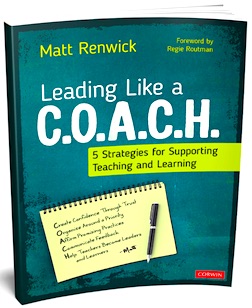Lead Like a COACH on Your Instructional Walks
Leading Like a C.O.A.C.H.: 5 Strategies for Supporting Teaching and Learning
By Matt Renwick
(Corwin, 2022 – Learn more)
Reviewed by Rita Platt

How do I know? Because I am a working principal with 27 years of experience in various leadership roles, and this book was the best professional read I’ve had in a long time.
In a nutshell, Wisconsin principal Matt Renwick’s thesis is that there are more “moving parts” in education today than ever before and if schools are to achieve excellence, then leaders must work in harmony with teachers, students, and families such that “we can become co-authors who collectively write our own school’s story.” (p. 1)

C.O.A.C.H. is both an acronym and an apt description of what Renwick says the best leaders do. He writes that the best way to support teachers and other staff is to “embrace the identity of a coach, one who supports and improves teachers’ thinking processes and resources to achieve goals while enhancing self-directed learning.” (p. 3)
C.O.A.C.H., in Renwick’s words, represents four primary areas of focus that lead to schoolwide success. The H underpins all of them as it “align[s] with the vision of any leader” and ensures the work of our educators ‘becomes more self-directed and sustainable over time.” (p. 2)
- Create Confidence
- Organize Around a Priority
- Affirm Promising Practices
- Communicate Feedback
All with the goal of
- Helping Teachers Become Leaders and Learners
Leading Like a C.O.A.C.H. consists of seven chapters. But before you read them, take the time to savor the foreword written by educational leadership treasure Regie Routman, as well as the introduction by the author. These short sections set the goals for the book and lay out the foundational beliefs that underpin every strategy shared in the pages to come.
The Method
Chapter One consists largely of the information I shared above. Chapter Two focuses on the backbone of learning to lead like a C.O.A.C.H. which is the practice of conducting Instructional Walks. Renwick read about the concept of Instructional Walks that Regie Routman shared as a part of her work on effective leadership. Renwick uses the process daily and calls them the “vehicle for engaging in coaching practices.” (p. 3)
In a nutshell, Instructional Walks are frequent, informal, and unannounced visits to classrooms. Renwick advocates discussing the process with staff and then engaging in the practice daily. He has seen the benefits of Instructional Walks in his many years of on-the-job research. Those benefits include:
1. Increased trust between teachers and administrators. Because the visits are frequent and very positive, teachers stop fearing a visit from the front office and start seeing the principal as a strategic partner in helping increase achievement.
2. Stress is reduced because the frequency of observation increases and the process is centered on offering positive, strength-based, supportive comments to teachers rather than “constructive criticism.”
3. The collaborative culture of the school increases as teachers become more interested in and comfortable with asking for feedback, problem-solving, and working with other teachers to improve instructional practices and outcomes.
Going Walking!
Chapter Two is centered on the concept and process for conducting Instructional Walks.
The method is simple and intuitive and likely not that much different from what effective leaders do and have done in successful schools for a long time.
1. Explicitly talk to staff about the what’s, why’s, and how’s of Instructional Walks and let them know you’ll be a frequent visitor in their classrooms. Be sure to emphasize that there is no judgment attached to your visits.
2. Make frequent random visits to classrooms at varied times and do not announce the visits. You want your time in the classroom to be as authentic as possible. Jot notes about what you see happening with a focus on the positive. Summarize the notes.
3. Scan the notes and put them in a digital folder. Give the handwritten notes to the teacher. Be sure to have a summarizing sentence or two that focuses on the positive. Share a verbal list of positives with the teacher and ask questions if you have them. Use the visit as a jumping off point for further conversation.
C.O.A.C.H.ing
The rest of the book is a series of five easy-to-read, practical chapters focused on each of the big ideas of the C.O.A.C.H.ing process. Keep in mind that each is a necessary piece of the Instructional Walk process.
Chapter 3: Create Confidence
The pivotal sentence in this chapter is “Leaders’ beliefs are realized in their actions.” (p. 44) Chapter Three centers on what Renwick calls the “four conditions for trust.” (p. 45) These conditions are
● Consistency
● Compassion
● Communication
● Competence
The author offers tips, ideas, and examples for leaders to model these conditions every day. If Instructional Walks are to be successful, teachers must have confidence in the leaders doing the walking. Further, he discusses how to build them into the fabric of the school community so that these “C”s are a matter of course for faculty and students alike.
Chapter 4: Organize Around a Priority
Here Renwick helps the reader determine what is needed at a school and how to prioritize change initiatives. He shares the importance of having a leadership team, developing a goal that is focused yet likely to provide diffuse benefits school-wide, and being sure that all stakeholders understand the priority and the goals associated with it.
This chapter is full of practical strategies for identifying priorities, aligning them with core values, and using data to monitor progress. My favorite section is subtitled “Create Collective Commitments Around Promising Practices” (p. 87) which brings us to chapter five.
Chapter 5: Affirm Promising Practices
Renwick says that affirmation is not just a pat on the back. Rather, he says, “True affirmations are valid. They are positive-oriented feedback you can substantiate with evidence. They are not a simple ‘good job.’” (p. 97) Positive affirmations are an integral part of Instructional Walks. In the best-case scenario, when leaders are participating in Instructional Walks, they have eyes toward the shared priorities of the school.
Chapter 6: Communicate Feedback
This chapter is all about how to “communicate feedback in a way that teachers hear it, consider it, and then act on it.” (p. 116) Renwick writes about offering written feedback as a part of the Instructional Walk process and as a part of regular face-to-face conversations with teachers. There are examples of conversations he has had with his staff along with questions to spur discussion.
Chapter 7: Helping Teachers Become Leaders and Learners
This last chapter helps the reader think about how the information in the preceding chapters can be used as a lever to engage teachers to become professional learners and even leaders in their own right. The bottom line is that when leaders create confidence, organize around a priority, affirm promising practices, and communicate feedback, they build learning and leadership into the culture of the school.
Great Book!
Lead Like a C.O.A.C.H.: 5 Strategies for Supporting Teaching and Learning is a truly wonderful book. It’s easy to read, grounded in real boots-on-the-ground work, and loaded with opportunities to reflect on and improve leadership practices. I recommend it to any educator who leads in schools. Superintendents, principals, deans, learning coaches, instructional specialists, department heads, PLC leaders, and other school leaders, this one is for you!
Rita Platt (@ritaplatt) is a National Board Certified teacher with master’s degrees in reading, library, and leadership. Her experience includes teaching learners in remote Alaskan villages, inner cities, and rural communities. She currently is a principal, teaches graduate courses for the Professional Development Institute, and is the author of Working Hard, Working Happy: Cultivating a Climate of Effort and Joy in the Classroom.


































